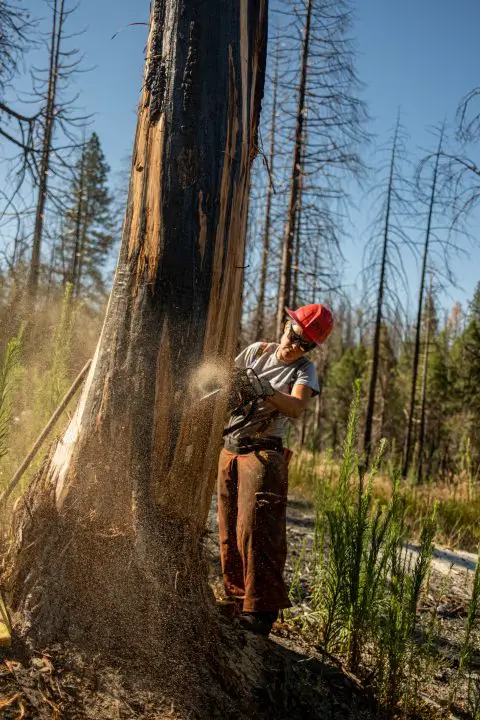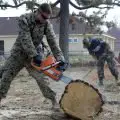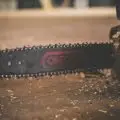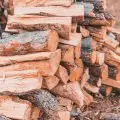Trees are an excellent addition to any landscape. They are attractive, create privacy, and provide shade. While trees undoubtedly provide numerous benefits, when they die, they can pose a slew of issues. Whether a tree on your property is dying as a result of a lightning strike or as a result of aging, getting the tree removed is critical.
In this article, we’ll discuss why cutting down dead trees is important, along with a step-by-step guide on how to do it safely and some tips!
Table of Contents
- Why You Should Remove Dead Trees
- How to Cut Down Dead Trees
- Cutting Down Dead Trees Tips
- FAQs (Frequently Asked Questions)

Why You Should Remove Dead Trees
- They attract pests
- They could fall
- They may impact other trees
- Cheaper to remove them now
- They’re unattractive
They Attract Pests
Pests find a dead tree particularly appealing. Termites, carpenter ants, and other wood-boring insects will seek out and colonize the tree. These bugs will swiftly spread, putting other trees or perhaps your house at risk of infestation.
Animals may also seek out the tree and nest in it. Rats are known to build nests in dead trees, and if a rat is in your dead tree, it will eventually infiltrate your home in search of food and more refuge.
They Could Fall
A dead tree isn’t as robust as a living tree, so it’s more likely to tumble over. It’s impossible to predict when a dead tree will fall, but it’s a very safe bet that it will. When it does fall, it may land on your house, your neighbor’s house, your fence, or any other piece of property, necessitating expensive emergency tree service.
There’s also a chance it’ll fall on someone, causing significant injury. If that dead tree falls, or has falling branches, and causes damage, you are responsible for any repairs or medical care that may be required as a result. Safety is imperative when tree trimming or felling trees.
They May Impact Other Trees
If a disease kills the tree, the rest of the trees in your yard may suffer as well. Tree disease is spreadable. For example, if mildew or mold grows on the tree, it has the potential to spread to the other trees and plants in your yard. As a result, just a single dead tree in your yard could devastate your entire landscape.
Cheaper to Remove Them Now
When a tree dies, its structural integrity is jeopardized. A burst of wind could blow, causing those dead branches to fall off. When a branch falls, it may land on a car, a fence, a roof, or even a person or animal. The resulting damage or injury could be severe. Having a tree removed before it falls can help you save a lot of money.
They’re Unattractive
Dead trees are simply unappealing. You want your yard to be as inviting as possible. When you have a tree that has no leaves, branches that are falling off, and bark that is flaking off, the aesthetic appeal of your yard suffers.
If your home’s curb appeal suffers, the value of your property may suffer, which could cost you money if you plan to sell.
How to Cut Down Dead Trees
Planning Dead Tree Removal
Before you begin, perform general maintenance and safety inspections. Fill up your chainsaw with gas and make sure the chain is properly greased, sharp, and tensioned. For more information visit our Chainsaw Maintenance Checklist & Chainsaw Bar Upkeep guides!
Look for hazards or obstructions that could cause the tree to fall. If feasible, remove any vines, smaller trees, and shrubs, and direct the planned fall away from power lines, buildings, streets, and anything else that cannot be removed.
Remove larger loose limbs of dead trees from the ground with a long-handled pruning saw before felling the tree if they appear unstable or likely to fall while you are cutting the trunk to avoid major mishaps. By carefully examining the tree’s lean, mark the target place where you will ideally drop the tree.
Determine the tree’s side-to-side lean in relation to the target by visually determining a line straight down from the tree’s farthest-reaching limb on either side as you face the suggested target location. Imagine a straight line to the ground that is half the distance between the two lines. This is the region to aim for side-to-side.
Repeat the method for the front and back of the tree, finding half the distance between the tree’s farthest leaning branches at the front and back. This will indicate whether the tree is leaning toward or away from your desired location.
Plan a safe withdrawal path away from the lean determined in the previous steps. This is the direction you should take as soon as the tree starts to fall. Clear the area for at least 15 feet of any trip hazards such as logs, vines, rocks, or other obstacles.
Before beginning to cut, be sure that people and pets are a safe distance away.
Cutting Down Dead Trees
How do you saw down a dead tree?
Total Time: 30 minutes
Cut a Notch
Cut a face notch in the direction of fall on the tree by cutting downward at a sharp angle into the tree such that the saw finishes about 2 or 3 inches into the tree in a line that crosses roughly 80% of the diameter of the tree. A 12-inch diameter tree, for example, would have a face notch about 9.5 inches broad at the base.
Make a Second Cut
Make a second cut below the first, angling in to meet the base of the first cut, creating a roughly 70-degree aperture when viewed from the side. The face notch is significant because it affects the direction of the tree’s fall.
Begin the Back Cut
Begin the back cut at the same level as the bottom of the face notch, or slightly higher. Making it higher is especially crucial if the tree has a tendency to lean slightly backward, as it will assist in forcing the tree to fall toward the face notch and the desired direction.
Stopping the Cut
Stop cutting when the back cut is within 10% of the diameter of the tree – a 1- to 1 1/2-inch space is sufficient for a 6- to 12-inch tree. Never cut all the way through to the face notch – the remaining unbroken part, known as the hinge, is important in carefully guiding the tree down.
Walk Away Via Planned Escape Route
As soon as you complete making the back cut and the tree begins to fall, turn off the chainsaw, set it down, and move quickly away from the tree in the intended escape route.
Cut Limbs into Logs
Return for the saw, cut limbs, and reduce the tree trunk to manageable logs only after the tree is safely on the ground.
Cutting Down Dead Trees Tips
Dead trees make great nesting and feeding places for many animals, so where it is safe to do so, consider leaving them in place. However, if the tree poses a hazard to people or property, the tree must come down.
Dead large trees are often difficult and dangerous to remove, so leave the big ones for a certified arborist who has the proper tools and adequate safety measures. Attempt to cut smaller trees only if you know what you are doing and have access to the correct equipment for the job.
If you wish to learn more about cutting down trees, visit our guides:
FAQs (Frequently Asked Questions)
Should I cut down dead trees?
Yes, you should cut down your dead trees as soon as possible. This is because they attract pests, they may fall and cause harm, they may infect other trees, they are less expensive to remove today, and they are unattractive.
How do you safely cut down a dead tree?
The rear cut and the undercut should not cross. Instead, leave a small gap between the two incisions. Insert a falling wedge into the back cut as quickly as feasible. The wedge will help ease the tree in the appropriate direction and can also assist you in adjusting if it begins to lean in the wrong direction.
Can you leave a dead tree in the ground?
You can, but a dead tree is very appealing to bugs. Termites, carpenter ants, and other wood-boring insects will seek out and colonize the tree. These bugs will swiftly spread, putting other trees or perhaps your house at risk of infestation.





